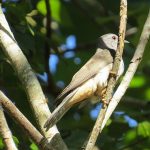BRUSH CUCKOO
The Brush Cuckoo has a wide distribution range that includes parts of Southeast Asia, Indonesia, New Guinea, northern Australia, and some Pacific islands.
In Australia, it is commonly found in the northern regions, including the northern parts of Western Australia, the Northern Territory, and northern Queensland. It is more widespread during the breeding season.
In eastern Australia, the Brush Cuckoo can be found in parts of Queensland, including the coastal areas and adjacent hinterlands. They are more commonly seen in these regions during their breeding season.
Their distribution may vary seasonally as they are known to be migratory within their range. During the non-breeding season, some individuals may move to different areas in search of food and favorable conditions. They are often associated with woodlands, forests, and other wooded habitats where they can forage for insects and establish their territories.
These cuckoos can be found in a variety of habitats, including rainforests, woodlands, mangroves, and even urban areas. They are known for their adaptability to different environments.
Brush Cuckoos are medium-sized birds with a distinctive appearance. They have a grey-brown plumage with fine dark streaks on the head, neck, and upperparts. Their underparts are paler, and they have a white crescent-shaped patch on the nape. Their eyes are surrounded by a bright yellow eye ring.
Brush Cuckoos primarily feed on insects, including caterpillars, grasshoppers, and other small invertebrates. They are often seen foraging for food in trees and shrubs.
Like other cuckoo species, Brush Cuckoos are known for their brood parasitic behavior. This means they lay their eggs in the nests of other bird species, often displacing the host bird’s eggs or chicks. The host bird then raises the cuckoo chick as its own.
Brush Cuckoos are known for their distinctive and melodious calls. They have a series of mournful, descending whistles that are often heard during the breeding season. These calls are used to attract mates and establish territory.
Some populations of Brush Cuckoos are migratory, while others are resident. The migratory individuals often move to different regions during the non-breeding season in search of food.
Habitat loss and fragmentation can pose a threat to them, especially in areas where forests are being cleared for development.
These birds play a role in controlling insect populations in the areas where they live. Their diet primarily consists of insects, which can help keep pest populations in check.

